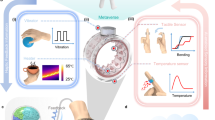Abstract
This paper provides a general overview of tactual displays (i.e., devices that communicate to a user through the sense of touch) and issues concerning the development of such displays for wearable computing. A wearable tactile directional display is presented. It takes advantage of a sensory phenomenon called ‘sensory saltation’ and simulates directional lines and simple geometric patterns dynamically. Initial results indicate that this information is intuitive and easy to interpret even for first-time users, and interpretations are highly consistent among observers. Several applications of this tactile directional display for wearable computing are proposed.
Similar content being viewed by others
References
Geldard FA (Ed.). Cutaneous Communication Systems and Devices, The Psychonomic Society, Inc., 1973.
Durlach NI and Mavor AS (Eds). Virtual Reality: Scientific and Technological Challenges. National Academy Press, Washington, D. C., 1994.
Reed CM, Rabinowitz WM, Durlach NI, Braida LD, Conway-Fithian S and Schultz MC. Research on the Tadoma method of speech communication, Journal of the Acoustical Society of America, 1985; 77(1): 247–257.
Eberhardt SP, Bernstein LE, Barac-Cikoja D, Coulter DC and Jordan J. Inducing dynamic haptic perception by the hand: system description and some results, Proceedings of ASME Dynamic Systems and Control, 1994; DSC 55(1): 345–351.
Wellman P and Howe RD. Towards realistic vibrotactile display in virtual environments, Proceedings of the ASME Dynamic Systems and Control Division, 1995; DSC 57(2): 713–718.
Linvill JG and Bliss JC. A direct translation reading aid for the blind, Proceedings of the Institute of Electrical and Electronics Engineers, 1966; 54: 40–51.
Bach-y-Rita P. Brain Mechanisms in Sensory Substitution, Academic Press, New York, 1972.
Craig JC. Plctorial and abstract cutaneous displays, In F. Geldard (Ed.), Cutaneous Communication Systems and Devices, 1973; 78–83.
Craig JC and Sherrick CE. Dynamic tactile displays, In W. Shiff and E. Foulke (Eds.), Tactual Perception: A Sourcebook, Cambridge University Press, 1982; (6).
Reed CM and Delhorne LA. Current results of field study of adult users of tactile aids, Seminars in Hearing, 1995; 16(4): 305–315.
Minsky M, Ouh-young M, Steele O, Frederick P, Brooks J and Behensky M. Feeling and seeing: Issues in force display, Computer Graphics (ACM), 1990; 24(2): 235–243.
Burdea GC. Porce and touch feedback for virtual reality, John Wiley & Sons, Inc, New York, 1996; (9).
Weisenberger JM and Percy ME. Use of the Tactaid II and Tactaid VII with children, The Volta Review, 1994; 96(5): 41–57.
Tan HZ, Srinivasan MA, Eberman B and Cheng B. Human factors for the design of force-reflecting haptic interfaces, Proceedings of the ASME Dynamic Systems and Control Division, 1994; DSC 55(1): 353–359.
Geldard FA. Sensory Saltation: Metastability in the Perceptual World, Lawrence Erlbaum Associates, Hillsdale, New Jersey, 1975.
Cholewiak RW, Sherrick CE and Collins A. Studies of saltation, in Princeton Cutaneous Research Project, Princeton University, Department of Psychology, 1996; 62.
Cholewiak RW. Exploring the conditions that generate a good vibrotactile line, presented at the Psychonomic Society Meetings, Los Angeles, CA, 1995.
Collins AA. Presentation at the Tactile Research Group Meeting of the Psychonomic Society Meetings, Oct. 31, 1996.
Author information
Authors and Affiliations
Corresponding author
Rights and permissions
About this article
Cite this article
Tan, H.Z., Pentland, A. Tactual displays for wearable computing. Personal Technologies 1, 225–230 (1997). https://doi.org/10.1007/BF01682025
Issue Date:
DOI: https://doi.org/10.1007/BF01682025




